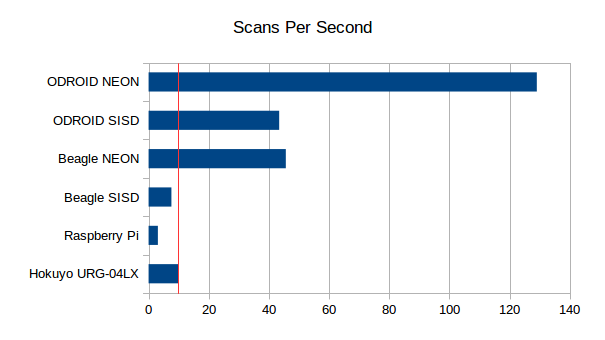BreezySLAM
Simple, efficient, open-source package for Simultaneous Localization and Mapping in Python, Matlab, Java, and C++
This repository contains everything you need to start working with Lidar -based SLAM in Python, Matlab or C++. BreezySLAM works with Python 2 and 3 on Linux and Mac OS X, and with C++ on Linux and Windows. By using Python C extensions, we were able to get the Python and Matlab versions to run as fast as C++. For maximum effiency on 32-bit platforms, we use Streaming SIMD extensions (Intel) and NEON (ARMv7) in the compute-intensive part of the code.
BreezySLAM was inspired by the Breezy approach to Graphical User Interfaces developed by my colleague Ken Lambert: an object-oriented Application Programming Interface that is simple enough for beginners to use, but that is efficient enough to scale-up to real world problems. As shown in the following code fragment, the basic API is extremely simple: a constructor that accepts Lidar parameters and the size of the map (pixels) and mapping area (meters); a method for updating with the current scan; a method that returns the current robot position; and a method for retrieving the current map as a byte array.
from breezyslam.algorithms import RMHC\_SLAM
lidar = MyLidarModel()
mapbytes = bytearray(800*800)
slam = RMHC_SLAM(lidar, 800, 35)
while True:
scan = readLidar()
slam.update(scan)
x, y, theta = slam.getpos(scan)
slam.getmap(mapbytes)
If odometry is available, it can also be passed into the update method.
Installing for Python
The BreezySLAM installation uses the popular distutils approach to installing Python packages, so all you should have to do is download and unzip the file, cd to BreezySLAM-master/python, and do
sudo python setup.py install
For a quick demo, you can then cd to BreezySLAM-master/examples and do
make pytest
This will generate and display a PGM file showing the map and robot trajctory for the Lidar scan and odometry data in the log file exp2.dat. If you have the Python Imaging Library installed, you can also try the log2png.py script to generate a a PNG file instead.
If you have installed Matplotlib, you can see a “live” animation by doing
make movie
You can turn off odometry by setting the USE_ODOMETRY parameter at the top of the Makefile to 0 (zero). You can turn off the particle-filter (Monte Carlo position estimation) by commenting-out RANDOM_SEED parameter.
To see what other features are available, do
pydoc breezyslam
By using the component classes Map, Scan, and Position and the distanceScanToMap() method, you can develop new algorithms and particle filters of your own.
Testing with the Hokuyo URG04LX
If you're running on Linux, you can install the BreezyLidar package, the OpenCV Python package, and try the urgslam.py example in the examples folder.
Testing with the GetSurreal XV Lidar
BreezySLAM now includes Python support for the inexpensive XV Lidar from GetSurreal. To try it out, you'll also need the xvlidar Python package. Once you've installed both packages, you can run the xvslam.py example in the BreezySLAM/examples folder.
Installing for Matlab
I have run BreezySLAM in Matlab on 64-bit Windows, Linux, and Mac OS X. The matlab directory contains all the code you need, including pre-compiled binaries for all three operating systems. To try it out in Matlab, add this directory to your path, then change to the examples directory and do
>> logdemo('exp2', 1)
If you modify the source code or want to build the binary for a different OS, you can change to the matlab directory and do
>> make
For making the binary on Windows I found these instructions very helpful when I ran into trouble.
Installing for C++
Just cd to BreezySLAM-master/cpp, and do
sudo make install
This will put the libbreezyslam shareable library in your /usr/local/lib directory. If you keep your shared libraries elsewhere, just change the LIBDIR variable at the top of the Makefile.
For a quick demo, you can then cd to BreezySLAM-master/examples and do
make cpptest
Again, you'll need to change the LIBDIR variable at the top of the Makefile in this directory as well, if you don't use /usr/local/lib.
Installing for Java
In BreezySLAM-master/java/edu/wlu/cs/levy/breezyslam/algorithms and BreezySLAM-master/java/edu/wlu/cs/levy/breezyslam/components, edit the JDKINC variable to reflect where you installed the JDK. Then run make in these directories, and also in BreezySLAM-master/java/edu/wlu/cs/levy/breezyslam/robots.
For a quick demo, you can then cd to BreezySLAM-master/examples and do
make javatest
Notes on Windows installation
Because of the difficulties that I and others have had installing Python extensions on Windows, I am no longer supporting the Python version of this package on Windows. If you want to try it yourself, here are some instructions.
To build and use the C++ library on Windows, I used MinGW. Whatever C++ compiler you use, you'll have to add the location of the .dll file to your PATH environment variable in the Advanced Systems Settings.
Adding new particle filters
Because it is built on top of the CoreSLAM (tinySLAM) code base, BreezySLAM provides a clean separation between the map-building and particle-filtering (Monte Carlo position estimation) components of SLAM. To add a new particle filter, you can subclass breezyslam.algorithms.CoreSLAM or breezyslam.algorithms.SinglePositionSLAM classes, implementing the relevant methods.
Copyright, licensing, and questions
Copyright and licensing information (Gnu LGPL) can be found in the header of each source file.
Personnel
Suraj Bajracharya, Simon D. Levy, Matt Lubas, Alfredo Rwagaju
Acknowledgments
This work was supported in part by a Commonwealth Research Commercialization Fund grant from the Center for Innovative Technology (CRCF #MF14F-011-MS). We thank Michael Searing of Olin College for his help in debugging and testing this package.
